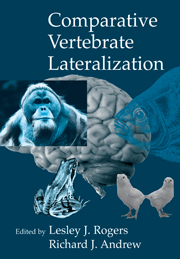Book contents
- Frontmatter
- Contents
- List of Contributors
- Preface
- Introduction
- Part one Evolution of lateralization
- Part two Development of lateralization
- Part three Cognition and lateralization
- Part four Lateralization and memory
- 14 Memory and lateralized recall
- 15 Memory formation and brain lateralization
- Epilogue
- Author Index
- Subject Index
- Richard Andrew
14 - Memory and lateralized recall
Published online by Cambridge University Press: 10 December 2009
- Frontmatter
- Contents
- List of Contributors
- Preface
- Introduction
- Part one Evolution of lateralization
- Part two Development of lateralization
- Part three Cognition and lateralization
- Part four Lateralization and memory
- 14 Memory and lateralized recall
- 15 Memory formation and brain lateralization
- Epilogue
- Author Index
- Subject Index
- Richard Andrew
Summary
Introduction
This chapter reviews the evidence for asymmetrical involvement of different forebrain structures at different times during learning and memory consolidation in the chick, focusing primarily on imprinting and one-trial passive avoidance. In doing so it covers the lateralized behavioural, electrophysiological, biochemical and structural processes that occur during memory consolidation. It concludes with a discussion of the functional relevance of the observed lateralization to theories of memory formation and storage.
Despite their overall gross anatomical similarities, the two cerebral hemispheres of many of the avian species studied to date show a remarkable degree of structural and functional lateralization. The directionality of lateralization in, for instance, chicks, zebra finches and canaries is the same in almost all individuals. Indeed, some of the earliest demonstrations of functionally lateralized brains in non-human species were in avian species (Nottebohm, 1971; Rogers and Anson, 1979; Scharff and Nottebohm, 1991; Cynx, Williams and Nottebohm, 1992).
This chapter is primarily concerned with the evidence for functional lateralization in one of the most thoroughly investigated avian models of learning and memory, the domestic chick (Gallus gallus domesticus). As we will describe, not only do chicks show brain asymmetries in processing information, akin to the lateralized functions of the mammalian brain (Bisazza, Rogers and Vallortigara, 1998) but the processes of memory consolidation and storage engage structures in left and right hemispheres differentially.
- Type
- Chapter
- Information
- Comparative Vertebrate Lateralization , pp. 533 - 581Publisher: Cambridge University PressPrint publication year: 2002
- 2
- Cited by



